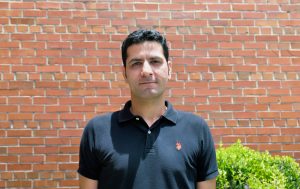
When Ehsan Amini was an undergraduate student in Iran, a close family member died as a result of a traffic accident. To better understand what had transpired, he set off on a journey that took him to the site of the accident.
“I traveled to the scene near Tabas, one of the ancient cities in Iran, and saw the location of the accident,” he said. “I realized that this accident could have been prevented if someone had just cared enough about designing better facilities. This event left a lasting impression on me and was a cue for things that lay ahead in my future.”
What lay ahead for Amini was a career as a transportation engineer. After completing his master’s degree in transportation and highway engineering at the Amirkabir University of Technology in Tehran, he began his doctoral program at the University of Florida under the guidance of Dr. Lily Elefteriadou, professor and director of the University of Florida Transportation Institute.
Amini graduated this spring (2022), but during his time as a doctoral student, he worked on mathematical modeling, motion planning for connected and autonomous vehicles, traffic simulation, and optimization and modeling.
He also worked on two projects funded by the Southeastern Transportation Research Innovation, Development, and Education (STRIDE) Center housed at the University of Florida Transportation Institute (UFTI). The two STRIDE projects were: 1) Assessing and Addressing Deficiencies in the Highway Capacity Manual (HCM) Weaving Segment Analyses- Phase II; and 2) Real-Time Data-Based Decision Support System for Arterial Traffic Management.
“In the HCM weaving segment project, we developed a model that is not only easier than HCM method, to be calibrated and be calculated, but also is more accurate than the method currently used in HCM6,” Amini said.
In that project, Amini was tasked with conducting the literature review and gathering information documenting deficiencies in HCM6. He also tested the current HCM method under various scenarios such as HCM6’s sensitivity to the length of the weaving section and the difference in the effect of ramp to freeway movement and capacity. He also worked on collecting field data from 35 weaving sections from various locations around the U.S. using Bluetooth sensors, loop detectors, video, and image processing. All this data was used to build models for estimating weaving section average speeds and capacity.
“I developed and calibrated several models that can estimate average speed of the weaving sections, and as a result, their capacity,” Amini said.
The second STRIDE project generated a new method of clustering and prediction for traffic. In that study, Amini collected the field data, ran traffic simulations, optimized traffic signals in the network, and tested and evaluated the accuracy of clustering methods. All this effort led to the development of a clustering algorithm for differentiating various traffic conditions based on specific parameters.
“We found that if we optimize the traffic signals based on the cluster that the algorithm predicts, we can improve the performance such as the average travel time and delay of the network by 7% compared to traditional methods,” he said.
Both projects that Amini worked on as a graduate student are important for society, the environment, and transportation professionals. For example, creating methods that accurately assess where the road infrastructure must be improved have economic implications, and improving travel time and decreasing delays in traffic translate into savings in travel time for drivers and therefore result in less carbon dioxide emission into the environment.
What began as a quest to find out why a loved one had perished in a traffic accident, ended up as a career in improving transportation for society in general, and that is something Amini’s family can be proud of.
Dr. Ehasan Amini graduated in May 2022 from the University of Florida and is now working as a research scientist at the UFIT’s McTrans Center.